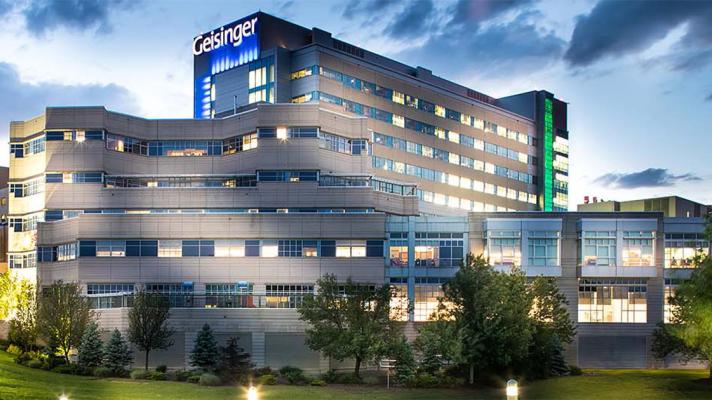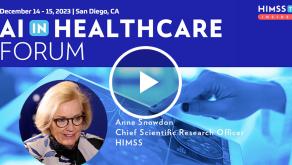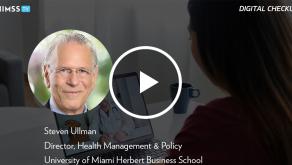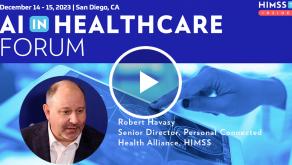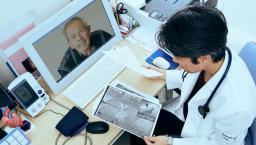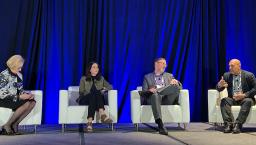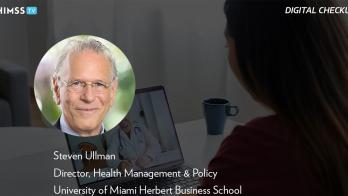How RPM can solve many patient and provider problems in rural areas

Kimberly O’Loughlin, CEO of Health Recovery Solutions
Photo: Kimberly O’Loughlin
Rural communities across the U.S. are facing an increasing healthcare crisis due to shortages in healthcare providers and facilities, especially as the nursing shortage continues throughout the country. One way people in these rural areas still can receive access to high-quality healthcare in a convenient and cost-effective way is through telemedicine and remote patient monitoring options.
Telemedicine in these areas provides chronic patients, for example, with access to medical specialists without traveling an extended distance, and can allow providers to identify particular social determinants of health such as lack of access to food.
We interviewed Kimberly O’Loughlin, CEO of Health Recovery Solutions, a remote patient monitoring company, to talk about the state of remote patient monitoring in rural America, trends in rural healthcare pushing RPM, drivers that encourage a rural hospital or health system CIO or clinical team to pursue RPM, and what CIOs and other health IT leaders should know about RPM before diving in.
Q. What is the state of remote patient monitoring in rural settings? Is there a lot of activity today? What's the typical patient look like?
A. While there is a need for remote patient monitoring in rural settings due to inadequate resources and limited access to medical facilities, actual utilization is low. Staffing shortages, budget cuts and low patient volumes coming out of the pandemic have forced some rural hospitals to shut their doors, with 19 closures in 2020 alone.
As hospitals unfortunately continue to close, there is an underlying expectation that RPM implementation will begin to increase in rural areas, yet the industry still has a long way to go before it maximizes the potential utilization of its capabilities.
Hesitancy in these rural settings stems from a variety of reasons, including unreliable internet connectivity, lack of appropriate credentials and licenses for nurses, and reimbursement barriers.
In rural areas where RPM services are currently being used, the patients are typically those who are older in age, managing chronic conditions, or recovering from a surgery or procedure. They typically need to pay closer attention to their health and benefit from monitoring, support and easy access to care.
As their health becomes more fragile, they may be unable to take themselves to and from appointments, especially when healthcare facilities are far away, as they are in rural communities. Family members may have to take them to and from appointments or doctors may have to travel to their homes, which can become a burden on family and caretakers.
This is where RPM fills a major need. Through RPM, elderly patients are able to monitor their own health from the comfort of their own home through easy-to-use communication tools and medical devices. Using an RPM platform, they are able to schedule appointments with their doctors themselves and ask questions without having to travel to the office.
In addition, many RPM solutions offer hospice and palliative care to allow patients to reach the end of their lives with dignity.
Apart from older patients, RPM is extremely valuable for those who are managing chronic conditions or recovering from surgeries. RPM provides tools like scales, blood pressure cuffs, blood oxygen monitors, educational content and surveys so patients with conditions such as diabetes, hypertension and COPD are able to monitor and better manage their own health.
With this constant tracking, providers can intervene when necessary for patients in rural communities, decreasing a patient's chances of hospital admissions or readmissions and increasing patient care plan adherence. Additionally, patients are even able to get a better understanding of their disease through patient education content and can speak with specialists virtually who may otherwise be hundreds of miles away.
Q. What are some trends in rural healthcare that are pushing RPM one way or the other?
A. Telehealth surged nationwide during the pandemic as lockdowns forced the entire country to stay inside their homes. Even as restrictions eased, many were still opting for virtual appointments to avoid leaving their homes for doctor's offices – particularly those in rural areas who may have difficulty accessing healthcare to begin with.
RPM was one type of solution that saw significant growth during the pandemic. However, with the public health emergency recently coming to an end, many patients, health systems and healthcare providers have been left wondering what’s next for RPM. Luckily, recent reports have stated that patients in rural areas will still have access to telehealth and RPM tools regardless of the end of the PHE.
This news yet again shows the positive effect RPM has on rural communities – and the promise that adoption of the tool will continue to grow.
With confirmation that rural populations will still have access to RPM tools, the push for these solutions is back on. We’re seeing a strong desire and advocacy for RPM because of the numerous benefits these solutions can bring.
Having quick and easy access to care is critical, yet some organizations serve a radius of about 300 miles, meaning patients would be forced to travel several hours to see a provider. Not only does this take up a large chunk of time but it also involves costly travel expenses. Since RPM enables patients to receive care virtually, it can help save time and money.
Another issue that many patients struggle with, particularly those in rural areas who may not see their provider face to face very often, is fully understanding their condition and treatment regimen. If patients don’t understand the importance of treatments, they may skip doses, not adhere to care plans, and therefore experience adverse effects.
To address this issue, most RPM services are equipped with automated reminders, education materials, and patient engagement capabilities to increase adherence helping them to better manage their medications, diets and exercises. Having these tools readily available for patients has resulted in positive feedback from users and addressed critical social determinants of health issues.
Another factor pushing RPM adoption is the ongoing nursing and clinical provider shortages. Many hospitals and clinics are currently operating short-staffed, and some have even been forced to close their doors due to the lack of nurses and physicians.
RPM can help alleviate this pressing issue because it allows nurses to monitor and care for patients quicker than in person. This extra time even allows them to see more patients during their shifts while avoiding overtime and hectic scheduling.
Lastly, RPM also enables providers to identify and address key social determinants of health that impact care access, such as language, health literacy and transportation, since virtual visits can help patients and providers overcome such barriers.
These benefits that nurses and physicians are seeing on a daily basis are helping to drive forward the urgency for RPM, particularly for those in rural or underserved communities.
Q. In your experience, what are the drivers that push a rural hospital or health system CIO or clinical team to pursue RPM?
A. A key driver that pushes rural hospital and health system teams to pursue RPM is the accessibility it provides to the communities they serve. Access to care is a necessity, yet in rural communities, finding an appointment or being able to physically make it to a hospital or clinic can be a challenge.
And, when patients are unable to take care of themselves or access care services, they may put off care until an illness becomes critical, resulting in emergency room visits and hospital admissions. Many patients are overdue for care as the public health emergency winds down. RPM can enable patients to better manage their health and wellness between visits as well as enable timely care when needed.
Another driver of RPM adoption is cost, as critical care has higher costs than routine or preventive care. Historically, cost has been a barrier to health systems’ implementation of virtual care due to the expenses of training, implementation and product costs, and the change management associated with the programs. Government-sponsored grants and loan programs can help organizations embrace the adoption of virtual technologies.
Delivery of better patient care is another key driver. Because patients are better able to monitor and manage their health from home, they are able to identify issues earlier, better adhere to care plans, and stay connected to clinicians and caregivers, avoiding a trip to the emergency room or a hospital stay.
On the provider side, the ability to better understand a patient's health between visits enables them to intervene when needed and provide the right care at the right time. In addition, due to medication reminders through these solutions, it is more likely that patients will adhere to their required medications and heal or manage their conditions properly.
Automated reminders also allow nurses to spend less time checking in with patients and more time caring for additional patients. The positive impact of RPM on readmission rates and outcomes has been proven: In one rural health system that uses RPM systems, readmission rates averaged only 6.6% over a 30-day period.
Q. Ultimately, what should CIOs and other health IT leaders at rural provider organizations know about RPM before diving into it?
A. They should be willing to learn about and embrace all of the capabilities and see the potential for scale these programs can provide to them and their patients. Some RPM technologies have customizable program features that can be leveraged as an organization’s needs change; therefore, understanding how to implement remote care delivery evolves based on the population of patients served.
For example, one rural clinic started with high-risk maternity and now is expanding to all maternity because of the high prevalence of diabetes and social issues that can affect outcomes. RPM programs aren’t one-size-fits-all and should evolve and expand for maximum benefit and impact.
With that, most RPM companies provide support for evolving needs and will help set the patient up with the technology and train them on how to use it, which takes the burden of logistics and training off the provider.
It’s been proven that patient engagement with RPM programs is high and users are able to carefully follow their care regimes virtually – showing the technology is being used to its full potential. According to recent studies by Mayo Clinic, 72.5% of more than 7,000 participating patients complied with their care plan tasks, including taking medications as well as monitoring their health and vitals regularly.
Additionally, only 9.4% of patients were readmitted to the hospital within 30 days of enrollment or discharge, whereas additional studies have found nearly 20% of patients not using RPM experience adverse events within 3 weeks of discharge.
Ultimately, RPM can help reduce barriers to care for those in rural populations. It creates more timely and consistent access for patients to seek care, saves staff time in seeing patients, and allows organizations to optimize care models with both in-person and virtual care which is a cost savings for organizations.
RPM platforms also make it easy for providers to record, store and access patient information, so they are not left writing up paperwork, entering it into systems, or digging through numerous files to find information on a patient. RPM systems can take much of the burden off of both physicians and patients, making the care experience a much more pleasant one.
Follow Bill's HIT coverage on LinkedIn: Bill Siwicki
Email him: bsiwicki@himss.org
Healthcare IT News is a HIMSS Media publication.




